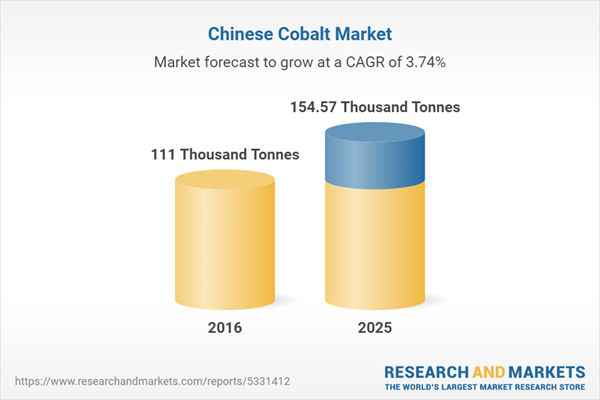By the end of 2020, global cobalt reserves totaled about 7 million tons, 3.60 million tons, or 50% of which were in Congo (Kinshasa). Australia, Cuba. Etc. accounted for 5% to 20% respectively while China only accounted for only about 1%.
In 2020, the global production volume of cobalt was about 140,000 tons, decreasing by nearly 3% YOY. The production volume of cobalt in Congo (Kinshasa) was about 95,000 tons, decreasing by nearly 5% YOY. Cobalt production declined consecutively in Congo (Kinshasa) from 2018 to 2020 because Luoyang Molybdenum’ TFM copper and cobalt mine, the world’s third largest cobalt mine, has reduced its production from 2019. Glencore’ Mutanda, the world’s largest mine, has been shut down for technical reforms for three consecutive years since 2020. At the same time, the new crown epidemic has affected the cobalt mining industry, resulting in insufficient cobalt supply, stimulating the rise of cobalt prices.
In recent years, global cobalt production stay above 130,000 tons per year and cobalt demand is also small. Therefore, cobalt prices can be easily manipulated to soar or slump, which is different from copper, aluminum, lead, zinc and other bulk commodities.
According to this market research, cobalt is mostly used in battery materials. It is estimated that in 2020, more than 60% of global cobalt consumption was attributable to the materials for 3C batteries, energy storage batteries, power batteries for new energy vehicles and other batteries. With the advent of 5G smart phones, 3C electronic shipments and unit charge will increase in the future. Mobile phones and new energy vehicles will account for about 70% of China's cobalt applications.
If there is no major technological innovation, the cobalt demand from cemented carbides, high-temperature alloys and magnetic materials will remain stable in the next few years. And battery materials will be the largest growth driver for the cobalt demand from 2021 to 2025.
It is expected that li-ion batteries for electric vehicles will be the largest growth area for cobalt consumption in the battery sector. In recent years, the global production volume of electric vehicles has been growing fast at a growth rate far exceeding that of traditional vehicles. In 2020, the production volume of electric vehicles in China reached about 1.456 million units, increasing by 22% as compared to 2019. The demand for cobalt, an important raw material for electric vehicle batteries, will continue to grow. Power batteries have taken up the largest proportion of the downstream applications of cobalt.
As global new energy vehicle industry is developing rapidly, the global cobalt demand will also continue to rise. It is expected that from 2021 to 2025, the global production volume of new energy vehicles will grow at a CAGR of around 40%, the cobalt demand from ternary materials will grow at a CAGR of about 50% and the demand for energy storage lithium batteries will grow at a CAGR of nearly 50%. Meanwhile, ternary batteries will see an increase in penetration rate and their demand for cobalt will grow at a CAGR of 80%. The cobalt demand from 3C batteries and industrial batteries will maintain a CAGR of about 5%. Overall, the CAGR of global cobalt demand will stay around 10% from 2021 to 2025.
Topics covered:
- Development environment for the cobalt industry
- Supply of and demand for cobalt on global and Chinese markets
- Analysis on major downstream industries of cobalt
- Price trend of cobalt
- Major cobalt mining and smelting enterprises and downstream enterprises in China and the world
- Driving forces and market opportunities for the cobalt industry from 2021 to 2025
- Threats and challenges to the cobalt industry from 2021 to 2025
- Prospect of global and China's cobalt industries from 2021 to 2025
Table of Contents
1. Basic Concepts of the Cobalt Industry
1.1. Definition and Classification
1.1.1. Definition
1.1.2. Classification
1.2. Development of the Cobalt Industry
1.2.1. Development of Global Cobalt Industry
1.2.2. Development of China's Cobalt Industry
1.3. Functions and Applications of Cobalt
1.4. Methodology
1.4.1. Parameters and Assumptions
1.4.2. Data Sources
1.4.3. About the Author
2. Development Environment for Global and China's Cobalt Industries
2.1. Economic Environment
2.1.1. Global Economy
2.1.2. China's Economy
2.1.3. Development of Global and China's New Energy Vehicle Industries
2.2. Policy Environment
2.3. Resource Environment
2.4. Development Environment for China's Non-ferrous Metal Industry
2.5. Major Downstream Applications of Cobalt
2.5.1. Li-ion Power Batteries (New Energy Vehicles)
2.5.2. Magnetic Materials
2.5.3. Alloys
3. Analysis on Global and China's Cobalt Industries
3.1. Analysis on Cobalt Supply
3.1.1. Cobalt Supply in the World, 2016-2020
3.1.2. Cobalt Supply in China
3.2. Analysis on Cobalt Demand
3.2.1. Cobalt Demand in the World
3.2.2. Cobalt Demand in China
3.3. Analysis on Import and Export of Cobalt in China
3.3.1. Cobalt Import
3.3.2. Cobalt Export
3.4. Price Trend of Cobalt, 2021-2025
3.4.1. Price Trend of Cobalt on the Global Market
3.4.2. Price Trend of Cobalt on the Chinese Market
4. Analysis of Industry Chain of Cobalt
4.1. Composition of Industry Chain of Cobalt
4.2. Upstream Raw Materials
4.3. Cobalt Smelting
4.4. Downstream Industries
5. Analysis of Competition in the Cobalt Industry
5.1. Barriers to Entry in the Cobalt Industry
5.1.1. Fund Barrier
5.1.2. Technical Barrier
5.1.3. Policy Barrier
5.1.4. Raw Material Barrier
5.2. Competitive Landscape of the Cobalt Industry
5.2.1. Bargaining Power of Upstream Raw Material Suppliers
5.2.2. Bargaining Power of Downstream Customers
5.2.3. Competition in the Cobalt Industry
5.2.4. Potential Entrants to the Cobalt Industry
5.2.5. Substitutes for Cobalt
6. Major Cobalt Smelters in China and the World, 2020-2021
6.1. Major Cobalt Mining and Smelting Enterprises
6.1.1. Glencore PLC
6.1.2. Vale S.A.
6.1.3. Eurasian Resources Group
6.1.4. Zhejiang Huayou Cobalt Co., Ltd.
6.1.5. Nanjing Hanrui Cobalt Co., Ltd.
6.1.6. Jiangsu Cobalt Nickel Metal Co., Ltd.
6.1.7. China Molybdenum Co., Ltd.
6.1.8. Jinchuan Group Co., Ltd.
6.1.9. China Railway Resources Group Co., Ltd.
6.1.10. Ramu Nico Management (MCC) Limited
6.2. Downstream Material Producers
6.2.1. GEM Co., Ltd.
6.2.2. Ningbo Shanshan Co., Ltd.
6.2.3. Beijing Easpring Material Technology Co., Ltd.
6.2.4. Xiamen Tungsten Co., Ltd.
6.2.5. Zhejiang Huayou Cobalt Co., Ltd.
6.2.6. Hunan Brunp Recycling Technology Co., Ltd.
6.2.7. Hunan Changyuan Lico Co., Ltd.
6.2.8. Ningbo Jinhe New Materials Co., Ltd.
6.2.9. Hunan Shenghua Technology Co., Ltd.
6.2.10. Shen Zhen BTR New Energy Materials Inc.
7. Prospect of Global and China's Cobalt Industries, 2021-2025
7.1. Factors Influencing Development of the Cobalt Industry
7.1.1. Driving Forces and Market Opportunities
7.1.2. Threats and Challenges
7.2. Forecast on Cobalt Supply, 2021-2025
7.3. Forecast on Cobalt Demand, 2021-2025
7.4. Trends of the Cobalt Industry
Selected Charts
Chart Cobalt Reserves in Major Regions of the World in 2020
Chart Policies on China's Cobalt Industry, 2016-2020
Chart Completed Fixed-asset Investment in China's Non-ferrous Metals Mining and Dressing Industry, 2016-2020
Chart Global Production Volume of Cobalt Ores, 2016-2020
Chart Global Production Volume of Refined Cobalt, 2016-2020
Chart Production Volume and Inventories of Cobalt in Major Cobalt Producing Countries
Chart Production Volume of Refined Cobalt in China, 2016-2020
Chart Production Volume of Cobalt Concentrates in China, 2016-2020
Chart Production Volume of Cobalt Ores in China, 2016-2020
Chart Consumption Volume of Cobalt in China and the World, 2016-2020
Chart Monthly Import Volume of Cobalt Ores and Concentrates in China, 2016-2020
Chart Import Volume of Cobalt Ores and Concentrates in China, 2016-2020
Chart Import Value of Cobalt Ores and Concentrates in China, 2016-2020
Chart Average Monthly Import Price of Cobalt Powder in China, 2016-2020
Chart Monthly Import Price of Refined Cobalt in China, 2016-2020
Chart Monthly Import Price of Cobaltosic Oxide in China, 2016-2020
Chart Monthly Import Price of Cobalt Hydroxide in China, 2016-2020
Chart Monthly Import Price of Cobaltates in China, 2016-2020
Chart Monthly Import Price of Cobalt Chloride, 2016-2020
Chart Price of Cobalt Oxide in China, 2016-2020
Chart Price of Electrolytic Cobalt in China, 2016-2020
Chart Composition of Industry Chain of Cobalt
Chart Global Distribution of Cobalt Reserves
Chart Cobalt Resources Obtained by Chinese Enterprises from Congo (Kinshasa)
Chart Global Consumption Volume of Lithium Batteries, 2016-2020
Chart Operation Performance of Zhejiang Huayou Cobalt Co., Ltd., 2016-2020
Chart Operation Performance of Nanjing Hanrui Cobalt Co., Ltd., 2016-2020
Chart Forecast on Global Production Volume of Cobalt Ores, 2020-2025
Chart Forecast on Consumption Volume of Cobalt in China and the World, 2020-2025
Samples

LOADING...
Companies Mentioned
- Beijing Easpring Material Technology Co., Ltd.
- China Molybdenum Co., Ltd.
- China Railway Resources Group Co., Ltd.
- Eurasian Resources Group
- GEM Co., Ltd.
- Glencore PLC
- Hunan Brunp Recycling Technology Co., Ltd.
- Hunan Changyuan Lico Co., Ltd.
- Hunan Shenghua Technology Co., Ltd.
- Jiangsu Cobalt Nickel Metal Co., Ltd.
- Jinchuan Group Co., Ltd.
- Nanjing Hanrui Cobalt Co., Ltd.
- Ningbo Jinhe New Materials Co., Ltd.
- Ningbo Shanshan Co., Ltd.
- Ramu Nico Management (MCC) Limited
- Shen Zhen BTR New Energy Materials Inc.
- Vale S.A.
- Xiamen Tungsten Co., Ltd.
- Zhejiang Huayou Cobalt Co., Ltd.
Methodology
Background research defines the range of products and industries, which proposes the key points of the research. Proper classification will help clients understand the industry and products in the report.
Secondhand material research is a necessary way to push the project into fast progress. The analyst always chooses the data source carefully. Most secondhand data they quote is sourced from an authority in a specific industry or public data source from governments, industrial associations, etc. For some new or niche fields, they also "double-check" data sources and logics before they show them to clients.
Primary research is the key to solve questions, which largely influence the research outputs. The analyst may use methods like mathematics, logical reasoning, scenario thinking, to confirm key data and make the data credible.
The data model is an important analysis method. Calculating through data models with different factors weights can guarantee the outputs objective.
The analyst optimizes the following methods and steps in executing research projects and also forms many special information gathering and processing methods.
1. Analyze the life cycle of the industry to understand the development phase and space.
2. Grasp the key indexes evaluating the market to position clients in the market and formulate development plans
3. Economic, political, social and cultural factors
4. Competitors like a mirror that reflects the overall market and also market differences.
5. Inside and outside the industry, upstream and downstream of the industry chain, show inner competitions
6. Proper estimation of the future is good guidance for strategic planning.

LOADING...
Table Information
| Report Attribute | Details |
|---|---|
| No. of Pages | 60 |
| Published | May 2021 |
| Forecast Period | 2016 - 2025 |
| Estimated Market Value in 2016 | 111 Thousand Tonnes |
| Forecasted Market Value by 2025 | 154.57 Thousand Tonnes |
| Compound Annual Growth Rate | 3.7% |
| Regions Covered | China |
| No. of Companies Mentioned | 19 |









